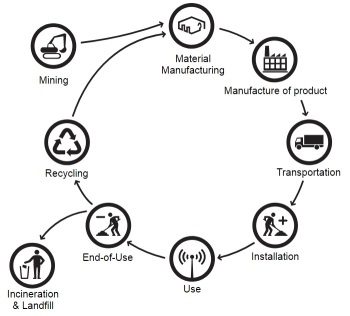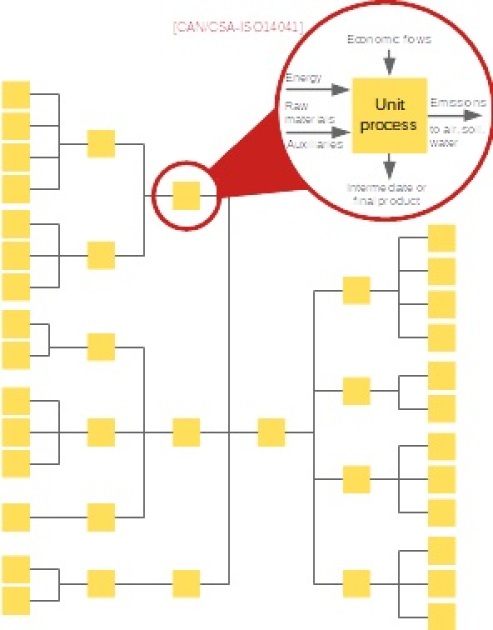Inventory analysis
Gathering information for LCA
Fondamental :
Gathering information is a key stage in LCA, as it requires rigorous identification and description of all the elements linked to the product, system or service concerned throughout its life cycle. This is known as the life cycle inventory (LCI).
Texte légal : Definition issued by the ISO 14040-44:2006 standard
LCI is the ‘phase of life cycle assessment involving the compilation and quantification of inputs and outputs for a given product system over its life cycle’.

Data for LCA
The LCA is used to build the model linked to the product, system or service under study, i.e. the life cycle tree.
Each box represents a process that forms part of the life cycle. Each box has inputs and outputs: these are the elementary flows of materials (or compounds) and energy and the associated emissions (into the air, water, soil, etc.). These flows can be expressed in kilograms, joules, kg CO2 eq, etc.
Data collection
There are a variety of sources and types of data
primary data (field data) or secondary data (generic data from databases);
measured, calculated or estimated data.
Where to find the data?
Direct measurements (consometer, weighing, 3D model, etc.)
Evaluation of chemical compounds (chromatography, SEM, infrared spectroscopy, ATG, etc.)
Identification of chemical materials and compounds (echa.europa.eu/fr/information-on-chemicals, csst.qc.ca/prevention/reptox/Pages/repertoire-toxicologique.aspx, scifinder-n.cas.org)
ICV databases (Agri-footprint, LCA Food, Ecoinvent, ELCD, INIES, ecosystem WEEE LCI, etc.)
Depending on the objectives and the nature of the product to be assessed, it may be preferable to choose one database rather than another (e.g. the BUWAL database is dedicated to packaging data).
How far to collect data?
It is sometimes impossible and/or pointless to model the whole system, for various reasons (very low weight compared with the rest of the system, excessively long modelling time, insignificant impacts, etc.).
A number of ‘cut-off’ rules have been put in place for this purpose.
Standard NF P 01-010 specifies that inclusion or exclusion criteria can be defined according to (1) the mass share; (2) a percentage of the cost; or (3) the share of contribution to environmental aspects.
Good practice standard BP X 30-323-0 suggests not excluding elements beyond 5% by mass, energy or environmental impact.
